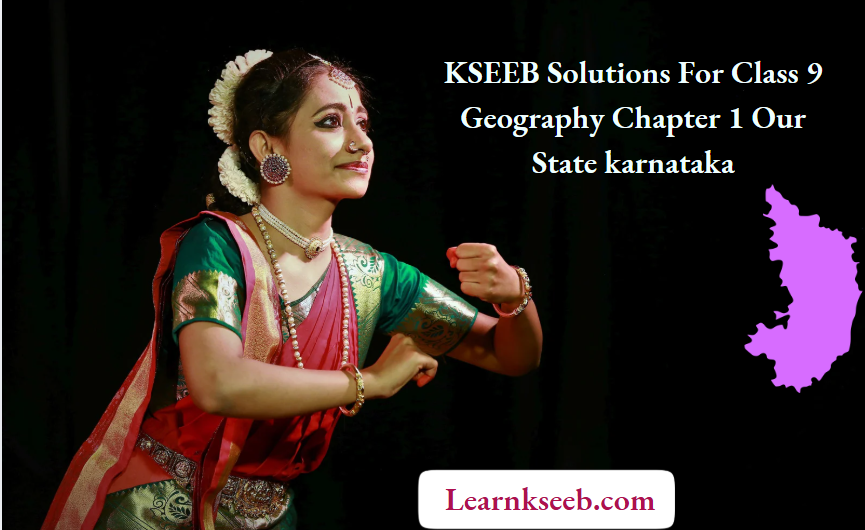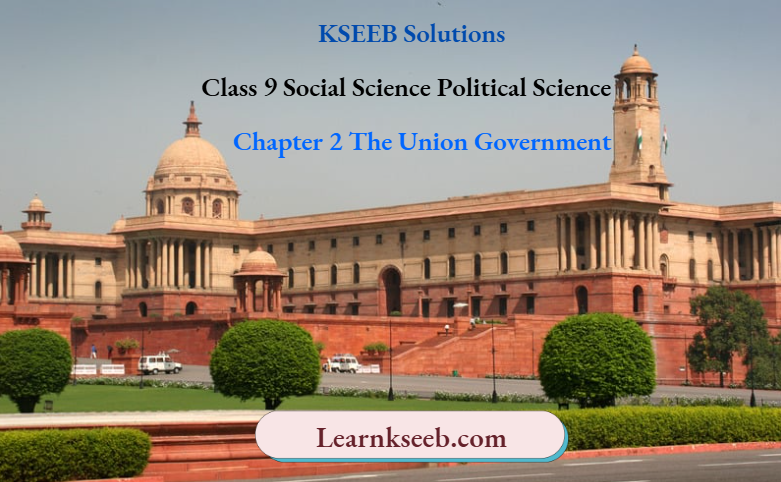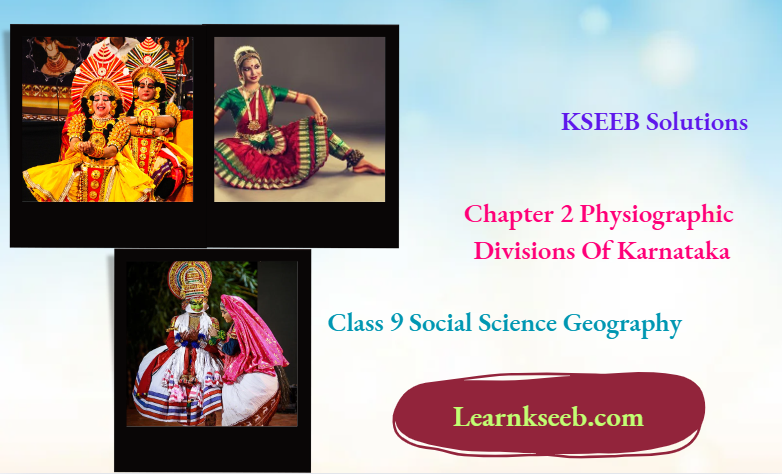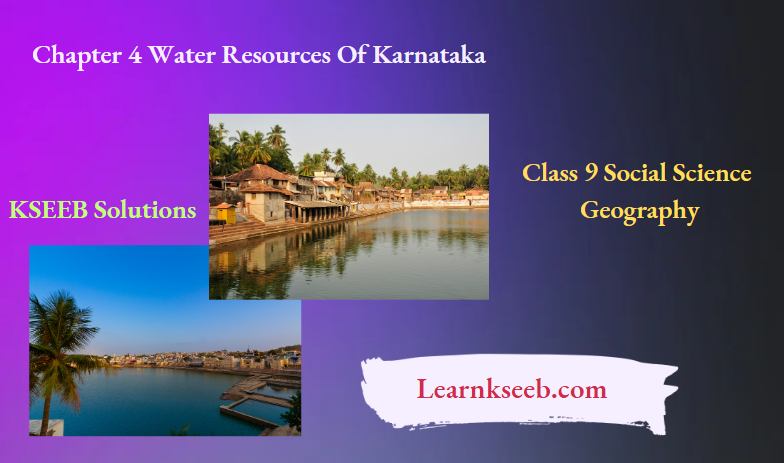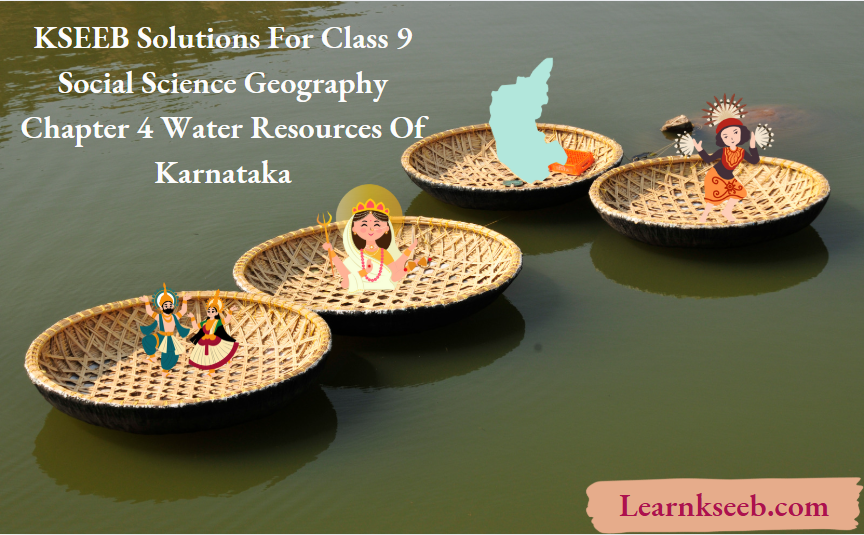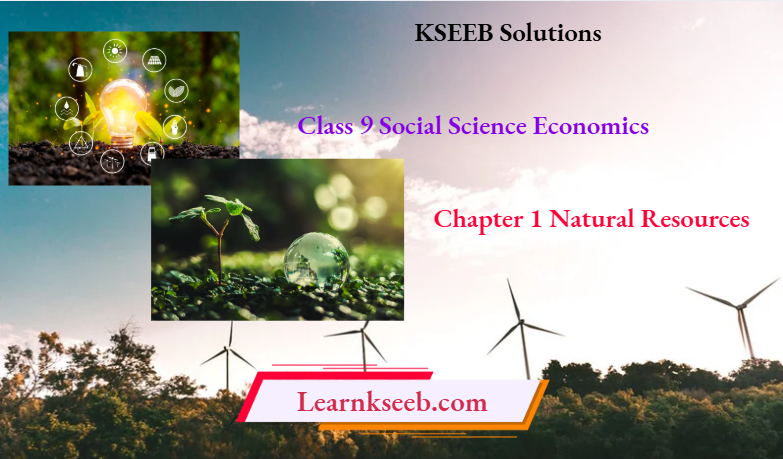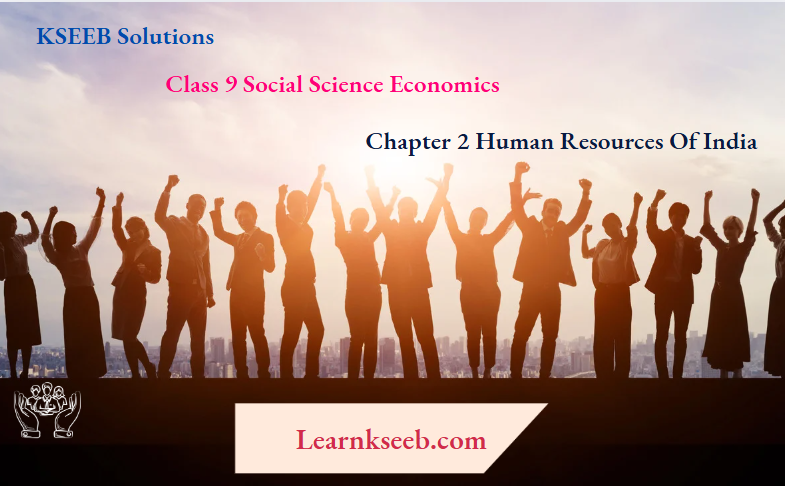KSEEB Solutions For Class 9 Geography Chapter 3 Climate, Soil, Natural Vegetation, And Animals Of Karnataka Points To Remember
The main characteristics of a tropical monsoon climate are hot and moist summers and cool and dry winters. The main reasons for this diversity are the influence of geographical location, oceans, physical features, vegetation, and monsoon winds. The four Climatic seasons of Karnataka are:
- The summer season (March to May)
- The rainy season (June to September)
- The period of Retreating Monsoons (October – November)
- The winter season(December – February)
- Raichur has recorded a temperature of 4 5.6°C and it is the hottest place in Karnataka.
- Since pre-monsoon showers enable the flowering of coffee plants, they are called ‘Cherry Blossoms’, and since they help the mango crop, they are also known as ‘Mango showers’.
- Agumbe is an area of heavy rainfall. Hence it is called ‘Cheerapunjiof South India’.
- Nayana Hatti near Chellakere in Chitradurga records the lowest rainfall.
- Due to the decrease in temperature and increase in pressure, the North-East Monsoon Season blow from the northeast to the southwest.
- January is the month that records the lowest temperature so it is called ‘The Tourist Month of the State’.
- The minimum temperature recorded is 6.7°C in Belgavi.
- The top thin layer of the earth’s surface is called soil. The soils of Karnataka have been classified into four types:
- Red soil,
- Black soil,
- Laterite soil,
- Coastal Alluvial soil.
| Class 9 Social Science | Class 9 Science | Class 9 Maths |
- Red Soil is obtained from the weathering of granite and gneiss.
- Black Soil is formed by the weathering of basalt rocks.
- Laterite Soil is found in areas that receive heavy rainfall and have high temperatures.
- Coastal Alluvial Soil is formed along the coast due to the deposition of alluvium and sediments carried by the rivers and sea waves.
- The various kinds of plants and trees growing naturally are referred to as ‘Natural Vegetation’.
- Sandalwood is a special tree grown in forests of Karnataka so it is known as ‘the Land of Sandalwood’.
- The Natural Vegetation of Karnataka has been classified on the basis of rainfall, relief features, and type of soil. They are:
- Evergreen forests,
- Deciduous forests,
- Mixed Forests and
- Grasslands and Shrubs.
- Areas receiving more than 250 cms rainfall annually have evergreen forests.
- After winter, due to a lack of moisture in the soil the trees of deciduous forests shed their leaves.
- The growing of evergreen and deciduous trees together forms mixed forests.
- Due to scanty rain and dry weather, there is short grass, thorny shrubs, and scrub vegetation,
- Deltas, estuaries, and beaches in coastal areas have a particular type of vegetation that has aerial roots and can grow in salty water called ‘mangrove forests.
- The deep valleys with streams, rills, etc. have distinct “Shola forests”.
- Uttara Kannada district has the maximum forest area where as Vijayapura district has the least forest area.
- The Sahyadris ranked amongst the hotspots of the world for their bio-diversity. Recently they have been declared a ‘World Heritage Area’.
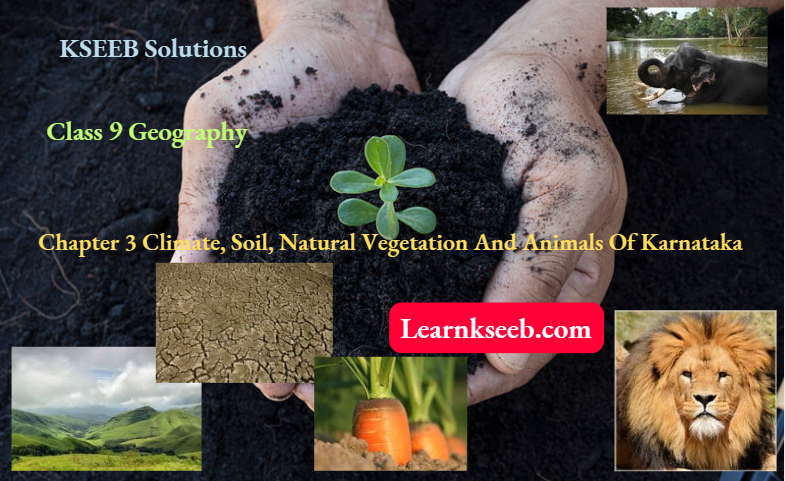
Climate, Soil, Natural Vegetation, And Animals Of Karnataka Textual Questions And Answers
Fill in the blanks with suitable words.
- The months of March to May form the summer season.
- The season with heavy rainfall is the South-West Monsoon Season/ Rainy Season.
- Extensive soil found in North Karnataka is Black Soil.
- The area that has evergreen forests is Areas receiving more than 250 cms rainfall.
- The district that has a large forest area in Karnataka is Uttara Kannada.
Discuss in groups and answer the following questions.
Question 1. Name the four seasons of Karnataka.
Answer:
The four seasons of Karnataka are:
- The summer season (March to May)
- The rainy season (June to September)
- The period of Retreating Monsoons (October to November)
- The winter season (December to February)
Question 2. Write a note on the rainy season in Karnataka.
Answer: The Rainy Season is also known as the season of South-West Monsoon winds. The We stem Ghats check the moisture-laden winds blowing from the Arabian Sea resulting in heavy rain whereas the eastern maidan remains as the rainshadow area. Agumbe, Bhagamandala, and Hulikal are places of heavy rainfall. Nayakanahatti near Chellakere in Chitradurga records the lowest rainfall. Karnataka receives about 80% of its rainfall.
Class 9 Geography Chapter 3 KSEEB Climate, Soil, Natural Vegetation, And Animals of Karnataka Notes
Question 3. Mention the types of soils found in Karnataka.
Answer:
The soils of Karnataka have been classified into four types. They are:
- Red soil
- Black soil
- Laterite soil
- Coastal Alluvial soil
Question 4. Name the types of natural vegetation found in Karnataka.
Answer:
The types of the natural vegetation of Karnataka are:
- Evergreen forests
- Deciduous forests
- Mixed Forests and
- Grasslands and Shrubs.
Question 5. Why is Karnataka known as ‘the Land of Sandalwood5?
Answer: Sandalwood is a special tree grown in forests of Karnataka so Karnataka is known as ‘the Land of sandalwood.
Question 6. Name the wild animals found in our forests.
Answer: Leopards, boar, bison, stag, deer, bear, porcupine, etc are found and a variety of snakes and colorful birds can also be seen in the forests of Karnataka.
Match the following.
A B
Adichunchanagiri Bird Sanctuary
Mandagadde National Forest
Nagarahole Deciduous forest
Sandalwood tree Peacock Sanctuary
Red soil
Answer:
A B
Adichunchanagiri Peacock Sanctuary
Mandagadde Bird Sanctuary
Nagarahole National Forest
Sandalwood tree Deciduous forest
Climate, Soil, Natural Vegetation, And Animals Of Karnataka Additional Questions And Answers
Choose the correct alternative and write the complete answer along with its alphabet in the sheet provided:
Question 1. In the list ‘A* group of geographical features and in list ‘B’ their places are given.
A B
Hottest place Chellakere
Heavy rainfall Kodagu
Lowest rainfall Raichur
Coolest Place Agumbe
Answer:
Hottest place – Raichur
Heavy rainfall – Agumbe
Lowest rainfall – Chellakere
Coolest Place – Kodagu
Question 2. Agumbe is called‘Cheerapunji ofSouth India’because
- It is in Assam
- Of its height
- It is located in the Western Ghats
- Of heavy rainfall
Answer: 4. of heavy rainfall
Climate, Soil, Natural Vegetation, And Animals Of Karnataka Class 9 KSEEB Solutions
Question 3. North-East Monsoon Season blows from the north-east to the southwest due to
- The decrease in temperature and increase in pressure
- The increase in temperature and pressure
- The decrease in temperature and decrease in pressure
- The increase in temperature and decrease in pressure
Answer: 1. The decrease in temperature and increase in pressure
Question 4. Karnataka receives convectional rain along with lightning and thunder in summer due to
- The decrease in temperature and decrease in pressure
- Great evaporation and rain-bearing clouds
- Moderate temperature and rain-bearing clouds
- Low temperature and rain-bearing clouds
Answer: 2. Great evaporation and rain-bearing clouds
Question 5. The period which has the uncertain weather condition is
- The summer season
- The rainy season
- The period of Retreating Monsoons
- The winter season
Answer: 3. The period of Retreating Monsoons
Answer the following question in a sentence each:
Question 1. The pre-monsoons are called ‘Cherry Blossoms’ in Karnataka. Why?
Answer: Since pre-monsoon showers enable the flowering of coffee plants, they are called ‘Cherry Blossoms.
Question 2. Why is the pre-monsoon called ‘Mango Showers’in Karnataka?
Answer: Since they help the mango crop, they are also known as ‘Mango showers’.
Question 3. January is called ‘the Tourist Month of the State’. Why?
Answer: January is the month that records the lowest temperature so it is called ‘the Tourist Month of the State’.
Question 4. How is Red soil formed?
Answer: Red Soil is formed due to the weathering of granite and gneiss.
Question 5. How is Blak soil formed?
Answer: Black soil is formed by the weathering of basalt rocks.
KSEEB Geography Class 9 Chapter 3 Karnataka Nature Invegetation Concepts
Question 6. How is Laterite soil formed?
Answer: Laterite Soil is found in areas that receive heavy rainfall and have a high temperature.
Question 7. How is Coastal Alluvial soil formed?
Answer: Coastal Alluvial Soil is formed along the coast due to the deposition of alluvium and sediments carried by the rivers and sea waves.
Question 8. What is meant by Natural Vegetation?
Answer: The various kinds of plants and trees growing naturally are referred to as ‘Natural Vegetation’.
Question 9. We find different types of Natural Vegetation in Karnataka. Why?
Answer: We find different types of natural Vegetation in Karnataka because of rainfall, relief features, and type of soil.
Question 10. After winter, the trees of deciduous forests shed their leaves. Why?
Answer: After winter, due to lack of moisture in the soil the trees of deciduous forests shed their leaves.
Question 11. What are mangrove forests?
Answer: Deltas, estuaries, and beaches in coastal areas have a particular type of vegetation that has aerial roots and can grow in salty water called ‘mangrove forests.
Question 12. What is Shola Forest?
Answer: The deep valleys with streams, rills, etc. have distinct “Shola forests”.
Answer the following question in 2-4 sentences each:
Question 1. What are the main characteristics of Tropical monsoon climate?
Answer:
The main characteristics of Tropical monsoon climate are:
- Hot and moist summers
- Cool and dry winters.
Question 2. The annual temperature and distribution of rain are not the same all over Karnataka. Why?
Answer:
The main reasons for this diversity are the influence of:
- Geographical location
- Oceans
- Physical features
- Vegetation
- Monsoon winds
Class 9 Geography Chapter 3 Important Questions KSEEB Karnataka Climate And Soil
Question 3. Name the different types of soil found in Karnataka.
Answer:
The soils of Karnataka have been classified into four types. They are:
- Red soil
- Black soil
- Laterite soil
- Coastal Alluvial soil
Question 4. Name the different types of Natural Vegetation found in Karnataka.
Answer:
The different types of Natural Vegetation found in Karnataka are:
- Evergreen forests
- Deciduous forests
- Mixed Forests
- Grasslands and Shrubs.
KSEEB Solutions for Class 9 Social Science Karnataka State Syllabus
KSEEB Solutions for Class 9 Social Science History
- Chapter 1 Christianity and Islam
- Chapter 2 Medieval India and Political Transition
- Chapter 3 Religious Promoters and Social Kingdoms
- Chapter 4 Vijayanagara and Bahamani Kingdoms
- Chapter 5 The Moghuls and the Marathas
- Chapter 6 Bhakti Panth
- Chapter 7 Europe in the Middle Ages
- Chapter 8 Modern Europe
- Chapter 9 Revolution and Unification of Nations
KSEEB Solutions for Class 9 Social Science Political Science
- Chapter 1 Our Constitution
- Chapter 2 The Union Government
- Chapter 3 State Government
- Chapter 4 Judicial System
- Chapter 5 Indian Election System
- Chapter 6 Defence of the Nation
- Chapter 7 National Integration
KSEEB Solutions for Class 9 Social Science Sociology
KSEEB Solutions for Class 9 Social Science Geography
- Chapter 1 Our State – Karnataka
- Chapter 2 Physiographic Divisions of Karnataka
- Chapter 4 Water Resources of Karnataka
- Chapter 5 Land Resources of Karnataka
- Chapter 6 Mineral Resources
- Chapter 7 Transport
- Chapter 8 Industries of Karnataka
- Chapter 9 Major Tourist Centers of Karnataka
- Chapter 10 Population of Karnataka
KSEEB Solutions for Class 9 Social Science Economics
- Chapter 1 Natural Resources
- Chapter 2 Human Resoruces of Inda
- Chapter 3 Poverty and Hunger
- Chapter 4 Labour and Employment
KSEEB Solutions for Class 9 Social Science Business Studies

